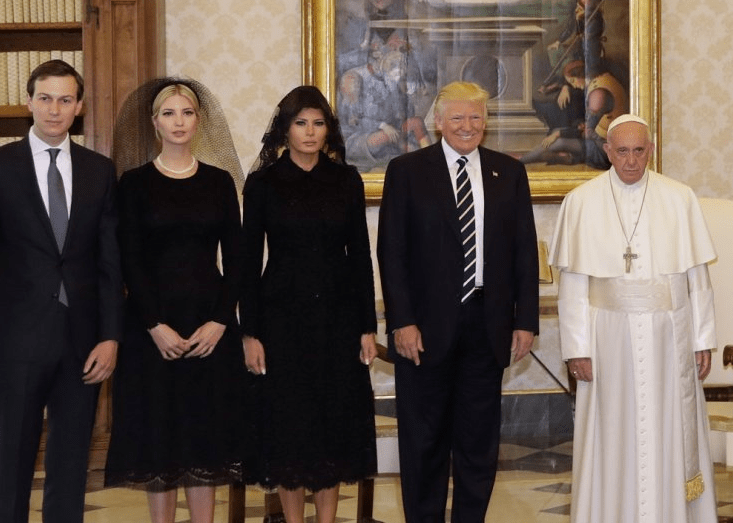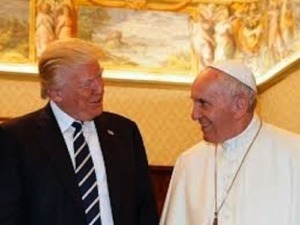Archbishop Charles J. Chaput, Strangers in a Strange Land (Henry Holt, 2017)
“Simply put, America can’t be the way it once was.” (Original italic.) This is not so much a lament as it is a reality check: Catholics upset with the culture can work to change it, but they cannot expect a return to more placid times. That is one of the most defining conclusions in this intellectually rich volume.
Archbishop Chaput has a great command of theology, history, sociology, and political science—his range is wide and deep—making him the right person to analyze current conditions and make cogent prescriptions for change. His love for the Church shines through over and over again, which is why this is a book that Catholics of every leaning can embrace.
What’s wrong with America is as obvious as it is distressing. The social order is in disarray on many fronts. Young people are spiritually lost, having no moral anchor to guide them. Pornography is commonplace; its destructive elements are wreacking havoc in relationships. Cohabitation and divorce are also creating problems for men, women, and children, fraying bonds that are integral to our well being. But there are some good signs.
We’ve made progress on abortion—especially among youth. “They’ve seen what abortion does. They’ve lived with the fact that they could have been aborted. The humanity of the unborn child is obvious on any ultrasound machine.” Where we’ve gone backwards, and nowhere is this more apparent than with young people, is with gay marriage and gender ideology.
June 2015 was a watershed moment in American history. That is when the U.S. Supreme Court, in Obergefell v. Hodges, imposed gay marriage on the states.
For Chaput, the effects were far reaching: “It changed the meaning of the family by wiping away the need for the natural relationships—husband and wife, mother and father—at the heart of these institutions.” Just as ominous, “the state implicitly claims the authority to define what is and isn’t properly human.” Indeed, he calls this ruling “poisonous,” precisely because it weakens marriage and the family, the two most important bedrocks of a free society.
Gender ideology is an offshoot of this phenomenon, blurring the lines between the sexes. Nature is the enemy: cultural elites teach that whatever exists is a social construction, having nothing to do with nature, or nature’s God. This represents “a revolt against biology itself—and it’s not without its own peculiar form of bullying.”
We have reached the state where those who do not accept gay marriage and gender ideology are condemned as bigots. Tolerance does not extend to those who believe in traditional marriage, or to those who see the sexes as binary, as either a man or a woman. Worse, when there is a showdown between gay rights and religious liberty, the latter is trashed, even though it is cited in the First Amendment (the Constitution says nothing about two men marrying).
These changes all took place in a nation dominated by Christians. Chaput notes that Catholics and Protestants have long shared the same basic faith and worldview, but success has spoiled us.
“Over time,” he writes, “we Catholics have succeeded very well—evidently too well.” Thus did we miss the opportunity to claim a “Catholic moment” in the culture. As a consequence, our “appetite for comfort and security has replaced conviction,” making it more difficult to bring about a much needed cultural renewal.
Our affluence is a function of our democratic and capitalist society, and while there is much to celebrate, it also has the effect of weakening the authority that resides in civil society. Parents, teachers, the clergy, and civic leaders have seen their moral muscles atrophy in the wake of the ever-increasing role of government. Now we take our cues from public opinion and market forces. The results are not sanguine.
We’ve been compromised. Truth is under attack, and the pernicious notion that all moral values are equal has triumphed. So we speak about “abortion rights” without ever saying exactly what the term means. The fluidity of our moral vocabulary allows us to skirt reality, bringing us to the point where “sucking the brains out of unborn children, or trading in their body parts, is not so appalling.”
Chaput does not sugarcoat our condition, but he is not without hope. “The gift of hope creates in us a desire for heaven and eternal life as our happiness,” he says. But to many Americans, despair and presumption have eclipsed hope. They are a reflection of our secular pursuit of progress, and our conviction that we need no external moral authority. This makes us more likely to follow the Machiavellian politics of a Saul Alinsky than to accept the challenges of the Beatitudes.
So where does this leave us? Citing an early Christian author who observed a similar condition, “They [Christians] live in their own countries, but only as aliens.” To understand Chaput’s point, consider that the subtitle to this book is Living the Catholic Faith in a Post-Christian World. That is our challenge: how do we as Catholics navigate the secularization of America, and the moral crisis it has spurred?
Contrary to what some commentators have said about Strangers in a Strange Land, Chaput is not asking us to throw in the towel; he asks that we consider how the early Christians handled their challenge. He says that “they didn’t abandon or retire from the world. They didn’t build fortress enclaves. They didn’t manufacture their own culture or invent their own language. They took elements from the surrounding society and ‘baptized’ them with a new spirit and a new way of living.”
In other words, for us to change society, we must first attend to our own spiritual health. What does it mean to be a Catholic? Recapturing our lost identity is not simply a good thing to do—it is the foundation of our ability to help renew the culture. There is much work to do: the baby boomers have failed to “pass along our faith in a compelling way to the generation now taking our place.”
Chaput outlines three challenges to the Catholic community: individualism, institutionalism, and clericalism.
“Christianity invented the idea of the individual.” (Chaput’s emphasis.) Yes, by stressing the unique God-given qualities that inhere in every individual, and by recognizing that we are all equal in the eyes of God, possessing the same human dignity, Catholic teachings transformed the traditional group identities of tribe, clan, kinship, and social statuses. Unfortunately, a modest interpretation of individualism has given way to an extremist one.
Radical individualism is not something to cheer about. The idea that we don’t need God—we are self-sufficient—is vacuous, failing to satisfy our base needs. “I’m spiritual, but not religious,” is a popular refrain, but it is a dodge. Indeed, the idea that we are on automatic pilot needing no external moral authority is absurd.
There is a Catholic tendency to see the Church as some huge institution that is self-propelling, needing little input from the faithful. This is the meaning of institutionalism, the fatuous notion that we do not have to participate in the life of the Church in order to remain Catholic. But what kind of Catholic is it that passes the buck, as well as the basket?
Clericalism is an unhealthy situation where the laity settle into a second-class condition, leaving to priests all responsibilities for governance. This cannot be corrected, however, by merely extending more rights to men and women in the pews—they must be willing to assume concomitant responsibilities. Many do not.
St. Augustine instructed us not to entertain the notion that a just and perfect social order is possible: we are all sinners, making perfectibility an illusion. But that doesn’t mean we do not have the power to transform society. Indeed, Chaput argues that “we can’t simply withdraw from public affairs.” So what should we do?
“The surest way to transform a culture is from the inside out.” What Chaput has in mind is “colonizing and reshaping the culture’s appetites and behaviors.” This begins at the micro level: he is not talking about some grand social engineering agenda, he is talking about you and me. “To recover the Church’s identity,” he contends, “we first need to recall our own.” That way we can “bring the Gospel to all those we encounter.” We are all called to do so.
This will not be easy. Chaput does not mince words: “The world hates the story Christians tell. It no longer believes in sin. It doesn’t understand the forgiveness of sinners.”
When I read those words, I immediately thought of Richard Dawkins, arguably the most famous atheist intellectual in the world. The English author says that sin is “one of the nastiest aspects of Christianity.” Of course, to admit to sin is to admit to God, and he will have none of it. And as Chaput informs, “If we don’t believe in the devil, sooner or later we won’t believe in God.”
Words such as sin and evil are no longer part of our vocabulary, though the experience of 9/11 helped to resurrect them for a while. In our therapeutic society of grief counselors and consoling dogs, human tragedy has nothing to do with sin: we can be reclaimed by talk, if not by yoga.
Despite the subtitle of Chaput’s book, he emphasizes that the first thing that God asks of us is “to realize that the words ‘post-Christian’ are a lie, so long as the fire of Christian faith, hope, and love lives in any of us.” But that means we cannot “tag along as compliant fellow travelers with a secular culture that’s now, in so many ways, better described as apostate.” (His accent.)
Chaput, then, is not preaching resignation, pulling back into some safe quarters. We have a moral duty to change ourselves and change society, but to do so we must be realistic: the secularism is stacked against us, requiring us to rebuild our Catholic identity in ways that work.
When I was a board member of the National Association of Scholars, a non-sectarian organization seeking to restore higher education, I was asked by the executive director to reach out to like-minded professors who belonged to NAS in the Pittsburgh area. We met from time to time in each other’s home, or on the campus of one of the colleges or universities.
The purpose of these meetings was to build bonds, to establish a confidence in our pursuit of truth, not politics. In short, to embolden us, thereby setting in motion a determination to change our institutions, knowing that we had the backing and resources of our colleagues. Did it work? Higher education is still a hotbed of activism, but matters would be worse if we simply went quietly into the night.
As Archbishop Chaput aptly notes, we have a moral duty to bring the Gospel to our fellow citizens, and that cannot happen if we run for safety, living in some cocoon. If we can transform the Catholic community, we can transform society, or at least put the brakes on our precipitous moral decline.

